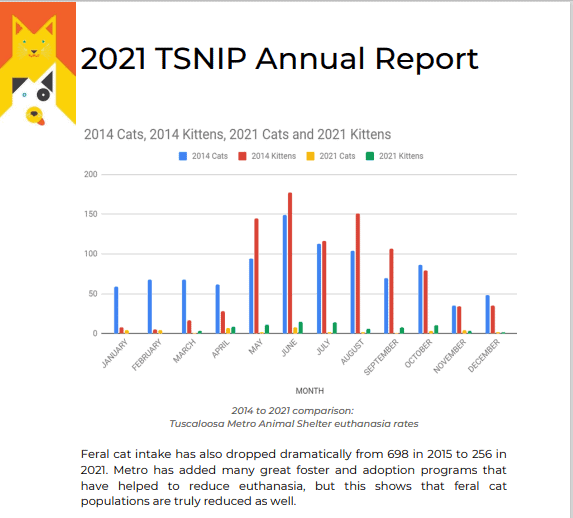Stray cats are multiplying in Tuscaloosa: here’s why
August 17, 2022
While most people assume that Tuscaloosa is synonymous with the word “football,” not everyone is aware of the city’s infamous abundance of stray cats and feral cat colonies.
According to the American Bird Conservancy, every year in the United States alone, cats kill more than 1 billion birds, an unsustainable level of predation for already-declining bird species.
While these effects are more dramatic in remote island environments like Hawaii, where it is estimated that feral cats have contributed to the extinction of nearly 33 native species, unmonitored feral cat colonies could create a similar imbalance in the local area.
The Tuscaloosa Spay & Neuter Incentive Program, began trapping through their Trap-Neuter-Return program in the spring of 2014, after the Tuscaloosa Metro Animal Shelter was forced to euthanize over 1,800 cats and kittens that year due to overcrowding. Since then, the non-profit organization has been supporting over 175 cat colonies in Tuscaloosa County.
By trapping, fixing and returning the cat to its colony, feral cats don’t have to undergo trauma waiting to be euthanized at an overcrowded shelter, nor will they reproduce or overhunt small birds and rodents.
Despite sometimes overhunting, Katie Elliot, the health, behavior and intake manager at Tuscaloosa Metro Animal Shelter, said controlled cat colonies are good for the environment because they prey on snakes and stabilize the populations of small prey.
“If you fix a colony instead of just relocating it or killing it, it actually maintains a stable environment and it prevents more cats from moving in,” Brinkman said. “If you get the cat fixed and you take care of its food and its prey drive in a healthy manner, then that’s not going to be an issue, right?”
According to the 2021 Annual Report from TSNIP, Tuscaloosa County has approximately 33,000 pet cats, with over 8,000 that can produce kittens. The city of Tuscaloosa has approximately 16,000 pet cats, 5,000 of which are not spayed or neutered and therefore can produce kittens if they escape or run away from home.
As is the case when most animal populations spiral out of control, human activity tends to be the root cause of the problem.
While releasing a pet into the wild does not always guarantee that it will quickly overpopulate its new environment, cats can have several litters a year.
Britni Hood, a coordinator at TSNIP, said it only takes one cat to start a feral colony.
“It only takes one female cat that hasn’t been fixed to be running around. They can have up to three litters a year. Six or eight kittens per litter,” Hood said. “It doesn’t take long at all for a cat colony to multiply.”
According to the official TSNIP website, community education and feral cat control are the two main ways in which people are working to lower the unwanted pet population.
Jessica Brinkman, the team leader at the Humane Society of West Alabama, said cats are multiplying so quickly in Tuscaloosa due to minimal spay and neuter laws as well as human neglect.
“Basically, there is ignorance in terms of pet ownership,” Brinkman said. “A lot of students will get cats or dogs off the internet for free. Mom and dad say, ‘No, you’re not bringing that home,’ and then they just dump them on the streets.”
Students often have limited budgets or unclear housing situations which may fluctuate on their allowance of pets.
Brinkman said Tuscaloosa does not regularly enforce the few spay and neuter laws it has, meaning many animals on the streets have never been fixed to begin with.
“There’s not a lot of low-cost spay [and] neuter options in town,” Brinkman said. “Students have a very limited budget. So, [the cats] haven’t been fixed and then they put them out on the streets and then they just breed and they explode from there.”
Feral cats don’t qualify for most rescue groups because they are not socialized well enough to live in captivity, meaning they can’t be housed in animal shelters.
On the other hand, abandoned, socialized housecats who are introduced to feral colonies will typically be perceived as a threat, as cats are extremely territorial, especially in the wild where they must fight for resources.
There are key indicators to look out for that will determine if a cat is feral or has been neglected and is still dependent on humans to survive.
Hood said the best way for students to help is to track the cats and get them fixed to stop the reproduction rather than uprooting them and risking stress and injury to both parties involved.
“They won’t let you approach them. They won’t let you get close to them. That’s what makes them feral is they don’t want human contact or interaction,” Hood said. “People tend to just pick up kittens and that’s when they get bit or scratched or injured.”
It is crucial to study the cat’s behavior and appearance to see if it has a tipped ear, which is the universal sign that the cat has been fixed.
“If you see a colony of cats and you notice that most of them have tipped ears, then that means that somebody is a caretaker of that colony,” Hood said. “That is kind of also how you can tell if a colony is maintained or not.”
Hood said people who call in to report a cat sighting usually team up with the volunteers at TSNIP to set up a safe, humane trap.
“What we do is we get them to start putting food inside of a trap. And every single day at the same time they put food out in the trap,” Hood said. “What that does is that teaches the cat to start eating inside of the trap. So, when we go to trap the cat, it won’t be this foreign object that shows up but they don’t really know what to do with and they’re scared.”
Once the cat is trapped, it is spayed or neutered and released in the same area where it was picked up.
Hood said people wanting to trap a cat should reach out to TSNIP or Tuscaloosa County Animal Control rather than attempting to approach the animal themselves.
“The best thing that I could recommend is if you see a cat and the cat is feral, and the cat doesn’t have its ear tipped, is to probably reach out, borrow a trap and let us arrange an appointment for it than it is to reach out and touch it,” Hood said.
Because rabies can only be diagnosed by direct examination of the brain, a cat suspected of biting and passing rabies to a human will most likely be euthanized if it cannot be monitored in a secure location, an unintended consequence of someone harming rather than helping.
While it is not uncommon for unsuspecting students to “rescue” strays, by doing so, they could disrupt the environment, create problems for volunteers or potentially harm the cat itself.
While TSNIP, Tuscaloosa Metro Animal Shelter and the Humane Society of West Alabama have all made leaps and bounds in working with the community to stabilize and control the local cat population, there are still plenty of things students can do to help to reduce euthanasia rates in Tuscaloosa to zero.
In only seven short years of the TNR program, there has been drastic success. The Tuscaloosa Metro Animal Shelter only euthanized 121 cats and kittens in 2021 compared to the 1,800 euthanized in 2014.
Elliot said using tools like social media is a great way for animal lovers to stay in the loop and connect with the resources needed to take care of all kinds of cat problems.
“Post pictures on Facebook. With a lot of people, their cats will get away from them, so they’re missing and come into the shelter looking for them,” Elliot said. “The quicker you get a picture uploaded, the quicker it helps us find out.”
All three organizations are actively accepting a variety of donations.
The Humane Society of West Alabama accepts monetary donations and has an Amazon Wishlist on their website for people to donate food, bedding, supplies and more.
Tuscaloosa Metro Animal Shelter accepts monetary and food donations, and even allows parents to give their child a visit to the animal shelter as a part of their birthday gift.
TSNIP uses their donations to provide need-based funding for surgeries, transportation and concentrated outreach in areas with higher levels of unwanted animals.










